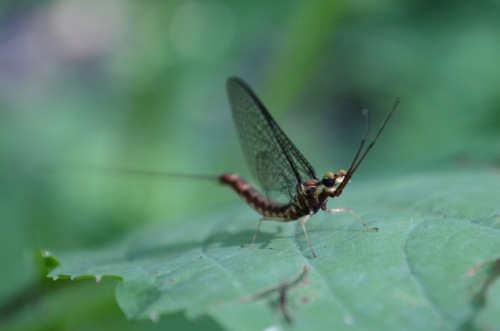Mayfly (Ephemeroptera), photo by Todd Marsee, Michigan Sea Grant
Last year Steve Stewart of Michigan State University Extension shared The Mayflies are coming – time to celebrate!:
It’s summer, so it’s time for the mayfly hatch! There are hundreds of species of mayflies (also commonly referred to as fish flies) in North America, representing a number of Families in the Order Ephemeroptera. Ephemeroptera comes from the Greek word for “short-lived” (as in “ephemeral”), and it’s a good name because as winged adults, mayflies only live a few days. The most widespread burrowing mayfly species in the Great Lakes is Hexagenia limbata, the Giant Mayfly.
Mayflies have a very interesting life cycle. They are the only insect to have two “adult” molts, and begin life as eggs laid on the surface of the water that sink to the bottom. The aquatic nymphs of mayflies are called naiads, and creep around rocks and vegetation. After months or years (depending on the species), they float to the surface and molt to a winged, but sexually immature, sub-adult. Often within hours, another molt occurs and the final stage emerges—the winged, reproductive adults, which possess only vestigial mouth parts and cannot eat or drink and, depending on the species, live for only days or, in some cases, mere hours.
One of the most obvious characteristics of the adults is their large numbers. They can emerge in huge numbers from a body of water. So huge, in fact, that their swarms can be seen on Doppler radar! This image is from June 14 showing a mayfly swarm over western Lake Erie, pushed ashore in Monroe County by an easterly breeze. Once ashore, mayflies tend to sit on upright objects and can completely cover the surfaces of posts, sheds, and light poles. At night, they are attracted to lights.
Some people think of mayfly hatches as a nuisance, and they can be a bit annoying when they are swarming. But mayflies are a good thing. Some people think of mayfly hatches as a nuisance, and they can be a bit annoying when they are swarming. But mayflies are a good thing. They are rarely found in degraded bodies of water because their external gills in the nymph stage are very vulnerable to silting and pollution. Mayflies are, therefore, used as an indicator species when testing for environmental quality, and their presence reflects the good quality of the habitat from which they hatched.
Read on for more including photos and school lessons on the Mayfly.
View this photo from the Michigan Sea Grant background bigtacular and see more of their mayfly photos on Flickr.
PS: Thanks to Absolute Michigan pool member Steve Brown for posting the first Mayfly of the season and alerting me.


I believe this is the mayfly we fishermen call the “White-Gloved Howdy”.
LikeLike
Yes, I believe so. Here’s a page that details it.
LikeLike
Fascinating stuff. :)
LikeLike